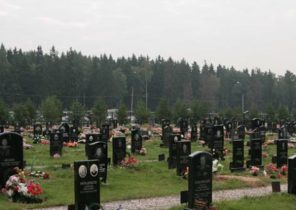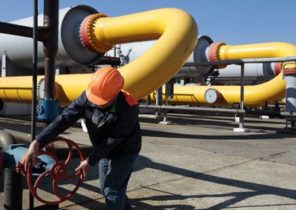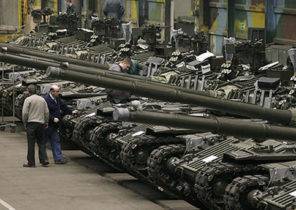Moscow — the Smell of diesel fuel was so unbearable that Vasily Ryabinin dizzy. This meant that he approached the scene of the accident.
Ryabinin, inspector Rosprirodnadzor, the Russian Federal service for supervision in the sphere of nature, alone went to the river Daldykan in the Siberian city of Norilsk, in order to see the consequences of a fuel leak at the metallurgical plant.
He also felt something else — a possible warning signs in relation to the plans of Russia, intend to aggressively expand its industrial and military footholds in resource-rich Russian Arctic, one of the regions of the world experiencing the most rapid warming.
This surge of climate change in Russia — more than three times higher than the average global level creates new risks on the way to the implementation of the program of President Vladimir Putin in the far North, one of its main national initiatives. The key danger lies in the construction of more infrastructure on the surface of a rapidly melting permafrost, ground that stays frozen from year to year.
Ecologists and other experts warn that as the destabilization of permafrost, accompanied by the reduction of the bearing capacity of the soil will occur and decrease stability built buildings, oil and gas pipelines, highways, Railways, and military bases.
That is, as the leadership of the metallurgical giant Norilsk Nickel, and occurred in late may, owned by CHP, located approximately 320 kilometres North of the Arctic circle. Due to the melting of permafrost subsidence occurs piles Foundation and depressurization of the tank with fuel, resulting in spilled 21 tons of diesel fuel, causing damage to the fragile ecosystem of nearby rivers and swamps.
“This area should be declared a zone of ecological disaster”, — says Roman Desyatkin, who lives in the Siberian city of Yakutsk in the study of permafrost.
“National pride”
Ryabinin, who grew up in Norilsk, have seen pictures of rivers Daldykan and Barn, which are due to the ingress of fuel has turned red. He decided to test it myself. According to him, security CHP first did not miss him and his chief on the scene of the accident, despite the fact that they work in the Federal service. But they reached the place from the railway tracks, passing more than a kilometer before the bridge over the river.
“We felt his scent over half a mile to the bridge, says Ryabinin. — And then we saw in the river is just a stream of diesel fuel.”
Four days later, Putin spoke about the spill of diesel fuel. During the teleconference, which was broadcast on state television, he told the Governor of Krasnoyarsk region and the head of a subsidiary of the plant that the public is rare. Some also believed that this is evidence of the concerns of the Kremlin regarding the implementation of its ambitious plans in the region.
Spill of fuel “was the signal for the Russian political leadership that the Arctic is not a trifle, — said Vladimir Chuprov, head of energy programs of the Russian branch of “Greenpeace” (Greenpeace). — The conditions are very harsh, and it’s very expensive.”
“But this is the most that neither is a political and national history, pride, where the Arctic is considered the personal history of President Putin,” he added.
In March, the Kremlin announced its ambitious program of development of the Arctic for 15 years, outlining an implementation plan for new energy projects and create tens of thousands of jobs that will attract the far North of new residents.
The document “On principles of state policy of the Russian Federation in the Arctic for the period up to 2035”, signed by Putin, was a fundamental expression of philosophy Moscow: Russia feels the effects of climate change, but perhaps she could use them to their advantage. Among the targets — the use of the Northern sea route for exporting oil and gas as the Arctic waters are increasingly free of ice.
This year was the earliest supply of liquefied natural gas via the Northern sea route to the East from Russian Arctic to China. The ship departed in may — more than a month earlier than in previous years. This summer is different, in all probability, the earliest beginning of navigation along the Northern sea route since the late 1970-ies began a constant satellite surveillance, when along the Siberian coast, the ice disappeared.
However, on land the warming climate may restrict the ability of Russian officials, who consider a bill granting free land to attract new Arctic inhabitants.
Last month in Yakutsk, the world’s largest city built on permafrost and is located approximately eight thousand kilometers East from Moscow, on a two-story apartment house there was a big crack. Due to the melting of the permafrost, the building was sunk, with the result that families were forced to urgently leave their homes.
Due to the melting permafrost of the largest Russian energy companies such as Gazprom, NOVATEK and Norilsk Nickel can suffer significant losses, the report says the Bank “Morgan Stanley” (Morgan Stanley), caught in the disposal of the Russian business daily Vedomosti. The report notes that about 90% of Russian gas and diamonds, 30% of the oil and all stocks of palladium are in areas covered by permafrost.
Unstable soil
For decades scientists warn that as global warming temperatures in the Arctic will rise faster than in other parts of the globe.
The decrease in snow and sea ice reflecting sunlight, and the darker land cover, which absorbs moisture, are factors contributing to the acceleration of the process known as increased melting of Arctic ice. And now it is happening with great speed.
According to one recent study, for six months from January to June, the temperature in most parts of North and Central Siberia was on nine with superfluous degrees above average.
It has a growing negative impact on this enormous region and in fact the rest of the globe. As a result of melting permafrost releases huge amounts of greenhouse gases, which over thousand years were “locked up” in partially decomposed organic matter.
Vladimir Romanovsky, an expert on climate at the University of Alaska in Fairbanks, which examines in detail the permafrost, says that the spillage of fuel in Norilsk should be a Wake-up call for the political leadership of Russia and other Arctic countries, pointing to the consequences of thawing permafrost.
According to him, June 20, in Verkhoyansk, a small town located North of the Arctic circle, the temperature was +38, which emphasized the urgency of the problem of destabilization of permafrost. This temperature value can be considered as the highest temperature recorded in the Arctic circle.
According to the Service monitoring of the atmosphere of Copernicus (Copernicus Atmosphere Monitoring Service), the scientific organization of the European Union, located in reading (England) in July, emissions from forest fires in the Arctic region, due mainly to the Siberian fires reached a record level. These fires have an indirect negative impact on permafrost, destroying vegetation, covering the ground in these areas with cold and humid climate, such as peat.
“Scientists have always warned that this would happen soon, but of course, politicians and those who make the decisions, should see what is happening, said Romanovskiy. — One alert enough to take it seriously”.
He was co-author of scientific articles published in 2018, according to which one third of its pan-Arctic infrastructure and almost 50% of oil and gas fields in the Russian Arctic is located in areas where melting permafrost could, by 2050, causing serious damage to infrastructure.
Now Romanovsky says that the results of the study may have been too low.
“It’s just a physical law that in a warmer climate will be the melting of permafrost, resulting in these critical situation will arise in more and more regions,” he said.
The consequences of a fuel spill
A secret visit by Ryabinina space of a fuel spill in the area of the river Daldykan 29 may was, in his words, “the last straw”.
Norilsk was built in Soviet times of the Gulag prisoners. Today, this industrial city with a population of about 175 thousand people, most of whom work in “Norilsk Nickel”, now has a bad reputation due to environmental disasters. In 2016, the result is similar to the fuel spill the water in the rivers also became red.
“If other businesses will use the same methods as Norilsk Nickel, it would mean the end of Arctic,” said Ryabinin.
Because the investigation of the effects of contamination from Ryabinina had a conflict with the leadership of Rosprirodnadzor, he quit and decided to record a 45-minute video, and show it as the diesel spread over a much greater area than acknowledged by all the others.
According to Ryabinina, the fact that he openly speaks about it, means that he and his family will have to leave Norilsk. He was joined by other people, beating the alarm.
“We saw that the design of an industrial object in the form of a tank has gone down a bit, and the base is way out of line”, — says Sergey Shakhmatov, the former Deputy Minister of natural resources and ecology of the Krasnoyarsk region and the Executive Director of the Federal open environmental platform “Russian green”.
“We don’t know whether this is due to the melting of the permafrost, he added — but we’re going to find out, and if this climate the cause is proven, then we have to reconsider the whole strategy in the Arctic — and not only Russia but also other countries such as the United States and Canada.”
For damages Norilsk Nickel, the world’s largest producer of Nickel and palladium, was fined $ 2.1 billion. In a statement the company said that it will appeal against this amount.
“The company confirms that the obligation to eliminate the consequences of the accident at their own expense”, — said in a statement.
Less than two months after the spill, the 21 tonnes of diesel fuel, “Norilsk Nickel” declared the second, smaller (as in the text — approx. transl.) the scale of the leak in the Arctic circle — from the pipeline in Krasnoyarsk region leaked about 45 tons of aviation fuel. According to environmentalists, such incidents are commonplace, but they usually don’t get such publicity, as the accident in Norilsk.
“On the agenda”
For 15 years, the program of the Kremlin include the development of scientific and engineering solutions to “prevent the damage that can cause to the infrastructure of global warming”, but they are not clearly defined. Vladimir Chuprov of Russian branch of “Greenpeace” said that the costs of full development of the Arctic, planned by Putin, can be too large, so his government with them, readily agreed.
“All these ideas reflected in all of these [the Kremlin] documents impossible,” he said.
Climate researcher Romanovsky from University of Alaska said that the new buildings should be constructed taking into account the melting of permafrost. One option is to raise the building on piles, forming a clearance between it and the surface of the earth, through which will pass the cold air that will prevent melting the frozen ground and keep the permafrost at a greater depth.
Chuprov did not really believe that because of one oil spill in Norilsk, Russia will introduce a radical change in its plans for Arctic development. He pointed to the oil giant Rosneft, headed by Igor Sechin, a close ally of Putin, who, according to the newspaper “Kommersant”, recently asked the government to allow his company to conduct exploration work of at least three sites, located partially within the boundaries of a protected nature reserve on the Taimyr Peninsula.
It is unclear whether or not Rosneft the go-ahead for these works.
“All these environmental problems have always been minor and they have never been given much attention, says chess, Executive Director of the environmental platform “Russian green”. — Now environmental issues included in the agenda, and they are in the top three.”







